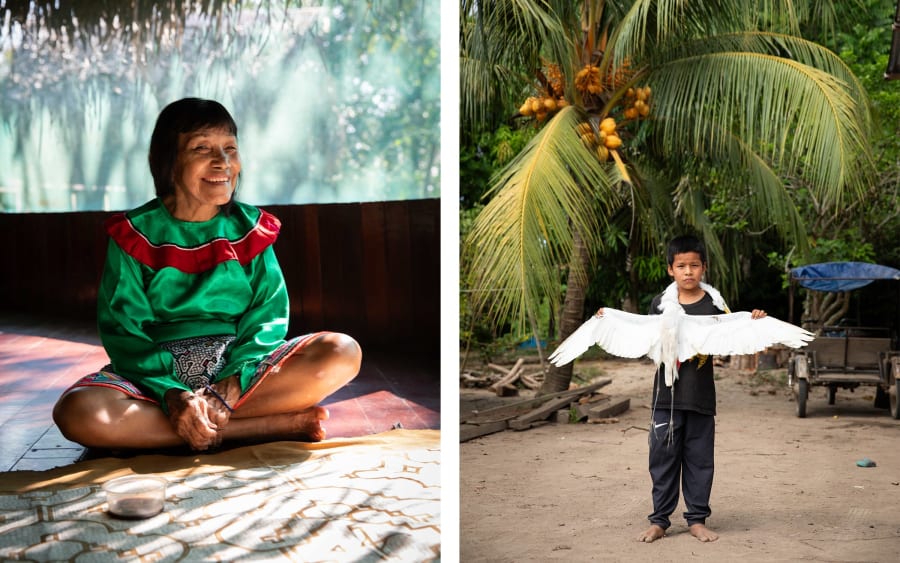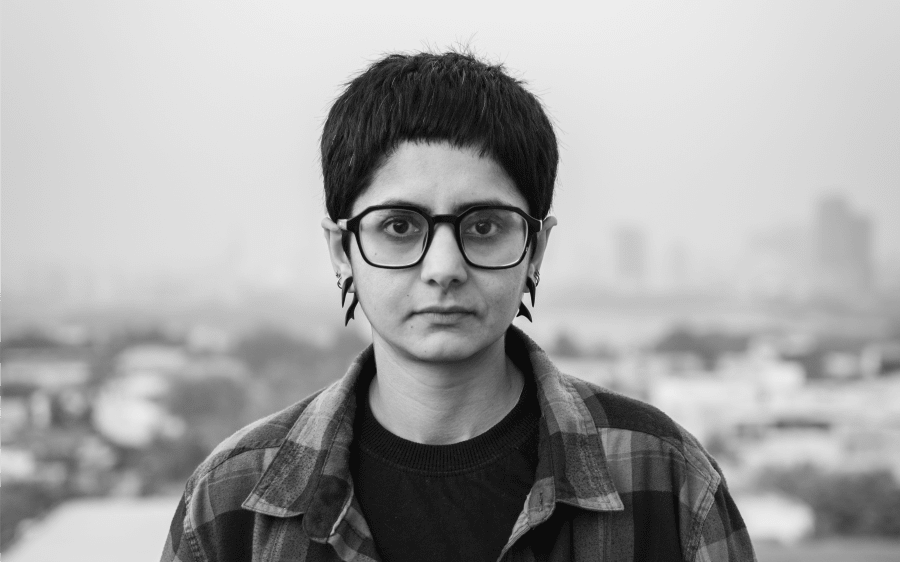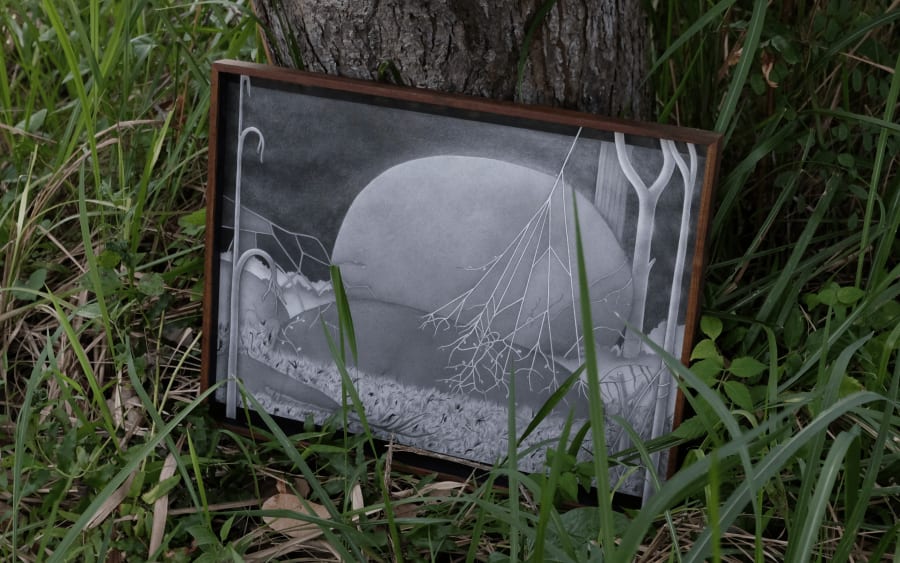Michaela Yearwood-Dan
Marianne Boesky Gallery
A gentle, pulsing vitality runs through the works of Michaela Yearwood-Dan. Lush and verdant, paintings such as Forgive you and forget you (2023) and It's gonna be alright this time (2023) all boast Yearwood-Dan’s floral flair and penchant for pulpy, pithy musings, that she inscribes upon the canvas. In the former, a spunky question, ‘Who gave you permission to rearrange me?’ hovers over the rich red of a flower, neatly tucked away in a small text box; in the latter, a delicate ‘It’s just the beginning’ traces the border of an emerald-green leaf. The effect is affective. Yearwood-Dan’s compositions, which channel influences as diverse as the cultures of Blackness, Queerness, femininity, and their attendant rituals, are bold but not overwhelming, rich but not indulgent, striking but not monolithic. Subtlety is the word: the botanical allusions that exist in Yearwood-Dan’s graphic vocabulary hide the political in the personal. Ubiquitous orange, pink, and purple hues bring to mind lesbian and bisexual pride flags as much as they do wild flowers, while swirls of brushwork that resemble carnations and pansies litter works such as La-dida (2023) with bright color bursts, evoking the sylvan charms of safe domesticity and the obscured Queer codes deployed in less progressive eras.
Li Hei Di
Pippy Houldsworth Gallery
For Li Hei Di, abstractions come with different textures. Appearing so soft and layered that they almost seem unstructured at first glance, pieces such as the sprawling diptych Liquid meadow in the lust of dawn (2022) feature complex brushwork in lurid, saturated colors: think blood stains and mucous trails. Meanwhile, Li deploys a garish visual grammar with a distinctively diaphanous quality in works such as The heaviest of burdens crushes us, we sink beneath it, it pins us to the ground (2023), obscuring organic forms with a shimmering, translucent film that glazes the visual field with a dreamlike haze. Roughly divided into two sections in a warm-cool color binary, a closer look at this painting reveals an embryonic figure curled up in an egg-shaped vessel rising above an embracing couple submerged beneath teal waves. Li’s inspirations are situated between an elusive, understated Eastern sensibility toward attraction, seen in works of Chinese cinema like A Chinese Ghost Story, Green Snake, and Swordsman II, and the frank poetics of Western feminist literature, citing writers such as Maggie Nelson and Virginia Woolf. What emerges are works that pivot away from the structural rigidities of conventional ideas around sexual attraction and desire to propose plural ways of being and wanting.
Radhika Khimji describes her works as existing simultaneously as ‘a painting, a drawing, and a collage... an embroidery and a sculpture.’ Khimji locates and dislocates the corporal form to imagine the kinetic potential of the errant self. In Lick the sky (2021), a figure appears both poised in a moment of transition from one visual field to another, and trapped within the suffocating net of a dotted landscape. Wrought with a peculiar tension, the figure’s torso appears clenched while its lower extremities, bulky and muscular, are loose and ready to move. This visual polarity is mirrored in the surrounding field: oscillating between almost-mechanical perforations and meticulous detailing, Khimji’s dot patterns embody an inherent contradiction, strengthened by a material tension of acrylic and glue over paper that alters the physical textures of the painting. By combining and overlaying multiple incarnations of abstraction across forms, materials, and patterns, Khimji’s deeply idiosyncratic vernacular imagines a universal truism: any attempt to contain the unruly edges of identity and memory will ultimately fail.
Waqas Khan
Sabrina Amrani Gallery
In the work of Waqas Khan, the laborious repetition of diminutive dots, dashes, and lines to create contours and shapes on canvas takes on distinctively ascetic qualities. Trained in printmaking and miniature painting, the totality of Khan’s visual field, which emulates the constellation of devotion in ritualistic practices, draws on both the meditative qualities of Sufism (a mystical form of Islam) and, at a closer look, its scriptural materiality. As Khan has said, the process of composing his works is not unlike writing: a dot, for him, is a word. In drawings such as Till we meet again (2024), precise marks circle into loops that build into each other to form a pair of webs on a rich indigo background. Reflective of Khan’s own cosmic sensibilities, the artist’s minimalist vocabulary pares abstraction down to the foundational roots of visual communication – mark-making – and evokes a celestial sublime through a gradual buildup of scale and complexity from the humble dot. This capture of abstraction at its most primordial and sublime creates a rich substrate for spiritual encounters. Taking on a textual dimension with its stunning uniformity and occasional breaks, the purity of Khan’s abstract language is austere yet approachable, proposing a dialogue with viewers that taps into the latent spirituality embedded within everyone, everywhere, every day.
Sara Flores
Clearing
Sharing an aptitude for repetition
with Khan, but with a formal, geometric rigor that draws on her Indigenous
Shipibo-Conibo heritage, Sara Flores – or Soi Biri in her birth name
– works predominantly in kené, a matrilineal Shipibo art form which
reflects on the hallucinatory visions obtained during ayahuasca ceremonies
through elaborate fractal patterns. In serial pieces ranging from Untitled
(Maya Kené 7) (2020) to newer works like Untitled (Tayan Kené 2) (2023),
Flores reveals stunning symmetries that portend deep curative and spiritual
powers derived from a reciprocal relationship with nature. Flores crafts her
own dyes from native flora of the Peruvian Amazon, which she then applies to tucuyo,
a wild cotton canvas, as part of her compositions. Derived from the soils of
Shipibo land, Flores’s meticulous hand-traced kené convey a sense of
calm and tranquility that exists in a radically different format from the
overwhelming and disorienting fractal patterns more commonly seen in
Euro-American psychedelia, offering an almost nurturing space for
contemplation. In this way, Flores captures and reappropriates the formalist
line and grid from its masculine Western sensibility into an expansive act of
relationality – weaving together, through the abstract, the tangible
threads of love and responsibility between mothers and daughters, people and
land.
Alfonse Chiu is an artist, writer, and curator based between Taipei, New Haven, and Singapore.
Full-bleed image: Li Hei Di, Liquid meadow in the lust of dawn (detail), 2022. Courtesy Pippy Houldsworth Gallery. © Li Hei Di.


